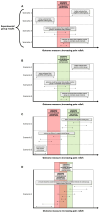Uncontrolled pain: a call for better study design
- PMID: 38420206
- PMCID: PMC10899387
- DOI: 10.3389/fvets.2024.1328098
Uncontrolled pain: a call for better study design
Abstract
Studies assessing animal pain in veterinary research are often performed primarily for the benefit of animals. Frequently, the goal of these studies is to determine whether the analgesic effect of a novel treatment is clinically meaningful, and therefore has the capacity to improve the welfare of treated animals. To determine the treatment effect of a potential analgesic, control groups are necessary to allow comparison. There are negative control groups (where pain is unattenuated) and positive control groups (where pain is attenuated). Arising out of animal welfare concerns, there is growing reluctance to use negative control groups in pain studies. But for studies where pain is experimentally induced, the absence of a negative control group removes the opportunity to demonstrate that the study methods could differentiate a positive control intervention from doing nothing at all. For studies that are controlled by a single comparison group, the capacity to distinguish treatment effects from experimental noise is more difficult; especially considering that pain studies often involve small sample sizes, small and variable treatment effects, systematic error and use pain assessment measures that are unreliable. Due to these limitations, and with a focus on farm animals, we argue that many pain studies would be enhanced by the simultaneous inclusion of positive and negative control groups. This would help provide study-specific definitions of pain and pain attenuation, thereby permitting more reliable estimates of treatment effects. Adoption of our suggested refinements could improve animal welfare outcomes for millions of animals globally.
Keywords: analgesia; animal ethics; farm animals; randomized controlled trials; study design.
Copyright © 2024 Hyndman, Bowden, Woodward, Pang and Hampton.
Conflict of interest statement
The authors declare that the research was conducted in the absence of any commercial or financial relationships that could be construed as a potential conflict of interest.
Figures


Similar articles
-
Small class sizes for improving student achievement in primary and secondary schools: a systematic review.Campbell Syst Rev. 2018 Oct 11;14(1):1-107. doi: 10.4073/csr.2018.10. eCollection 2018. Campbell Syst Rev. 2018. PMID: 37131395 Free PMC article.
-
The future of Cochrane Neonatal.Early Hum Dev. 2020 Nov;150:105191. doi: 10.1016/j.earlhumdev.2020.105191. Epub 2020 Sep 12. Early Hum Dev. 2020. PMID: 33036834
-
Pain and Laboratory Animals: Publication Practices for Better Data Reproducibility and Better Animal Welfare.PLoS One. 2016 May 12;11(5):e0155001. doi: 10.1371/journal.pone.0155001. eCollection 2016. PLoS One. 2016. PMID: 27171143 Free PMC article.
-
Safety and effectiveness of parent- or nurse-controlled analgesia in neonates: a systematic review.JBI Evid Synth. 2022 Jan 1;20(1):3-36. doi: 10.11124/JBIES-20-00385. JBI Evid Synth. 2022. PMID: 34387281
-
Telephone interventions for symptom management in adults with cancer.Cochrane Database Syst Rev. 2020 Jun 2;6(6):CD007568. doi: 10.1002/14651858.CD007568.pub2. Cochrane Database Syst Rev. 2020. PMID: 32483832 Free PMC article.
Cited by
-
Application of Infrared Thermography in the Rehabilitation of Patients in Veterinary Medicine.Animals (Basel). 2024 Feb 23;14(5):696. doi: 10.3390/ani14050696. Animals (Basel). 2024. PMID: 38473082 Free PMC article. Review.
References
-
- Retnam L, Chatikavanij P, Kunjara P, Paramastri YA, Goh YM, Hussein FN, et al. . Laws, regulations, guidelines and standards for animal care and use for scientific purposes in the countries of Singapore, Thailand, Indonesia, Malaysia, and India. ILAR J. (2016) 57:312–23. doi: 10.1093/ilar/ilw038, PMID: - DOI - PubMed
-
- Palmer C, Fischer B, Gamborg C, Hampton JO, Sandoøe P. Wildlife research: Toe-clipping. Wildlife ethics: Ethics in wildlife management and conservation. Oxford, United Kingdom: Wiley-Blackwell. (2023). 216–229.
-
- Alberthsen C, Waudby HP, Wilkinson LL, Lunney D, Bathurst M, Smith BP. Animal ethics committees In: Smith BP, Waudby HP, Alberthsen CA, Hampton JO, editors. Wildlife research in Australia: Practical and applied methods. Melbourne, Australia: CSIRO; (2022). 19–28.
Publication types
LinkOut - more resources
Full Text Sources
Miscellaneous

